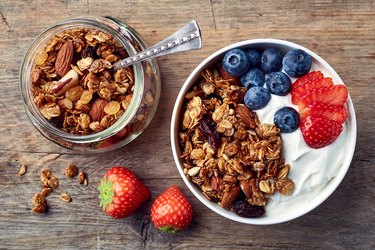
Yogurt and granola team up to provide you with a delicious and satisfying breakfast or snack. In terms of health, though, a lot depends on the varieties of yogurt and granola you purchase and the size of your portions. To keep your yogurt and granola a healthy choice, make sure you choose low-fat yogurt and granola with the least amount of added sugar — and stick to suggested serving sizes.
Tip
Stick to the serving size listed on the package for both yogurt and granola to keep your snack healthy.
Video of the Day
Choose Yogurt with Care
Yogurt provides a variety of nutritional benefits, including calcium for strong bones and teeth and satisfying protein to help build muscle and power you through the day. It also supplies probiotics, friendly bacteria that aid digestion. As a dairy food, though, it contains saturated fat, considered an unhealthy fat. A 1-cup serving of plain, whole-milk yogurt supplies 5 grams of saturated fat, or 26 percent of the daily value if you follow a 2,000-calorie diet. Excess saturated fat consumption has links to higher blood cholesterol levels, which puts you at risk for heart disease, cautions the American Heart Association. Opt instead for low-fat or nonfat yogurts, which will reduce your saturated fat intake — especially if you also consume meat and other animal products.
Video of the Day
Some yogurt brands feature scrumptious-sounding flavors, but these varieties contain added sugar and boost the calories in your otherwise healthy yogurt. Choose plain yogurt, either regular style or Greek, and mix in your own flavors or cut-up fruit. Drizzle a little honey through your yogurt or add 1/4 to 1/2 cup of your favorite berries to keep things healthy.
If it's protein you're after, low-fat Greek yogurt contains more than regular yogurt, with 20 grams in a 7-ounce serving compared to 13 grams in a cup of low-fat yogurt. With calcium, though, regular low-fat and nonfat yogurt surpass Greek style, supplying 34 to 38 percent of the daily value in 8 ounces, while you get just 18 percent in a serving of Greek yogurt.
Read More: What Are the Benefits of Yogurt and Granola?
Pair With Low-Sugar Granola
A basic granola recipe consists of oats, nuts, seeds, honey or another sweetener and a little oil, baked until crisp and golden brown. Given these simple ingredients, granola itself is a healthy food. The oats supply fiber to keep you regular, while you get protein and heart-healthy unsaturated fats from the nuts and seeds. The best option for keeping granola a smart and nutritious choice is to make your own; while it's easy, you may not have the time to spare.
Be careful of processed granola, and read its nutrition labels. Manufacturers load their products with sugary additions like chocolate chunks and sweetened fruit, making them more suitable for dessert than breakfast and boosting their sugar content. Excess sugar in the diet may contribute to myriad health issues, from dental problems to heart disease and strokes. Berkeley Wellness, a program at the University of California, suggests buying granola brands that contain between 4 and 6 grams of sugar per serving.
And that's the second issue: serving size. Nutrition labels for granola specify that a serving is small, either 1/4 or 1/3 cup. If you portion out more than that for a yogurt and granola bowl or parfait, you will significantly increase your calories. A cup of homemade granola, for example, contains a whopping 597 calories — twice as much as a fast-food hamburger. Stick with 6 to 8 ounces of yogurt topped with the recommended serving of granola for the healthiest combo.
Read more: The 6 Best Granolas and 4 to Avoid